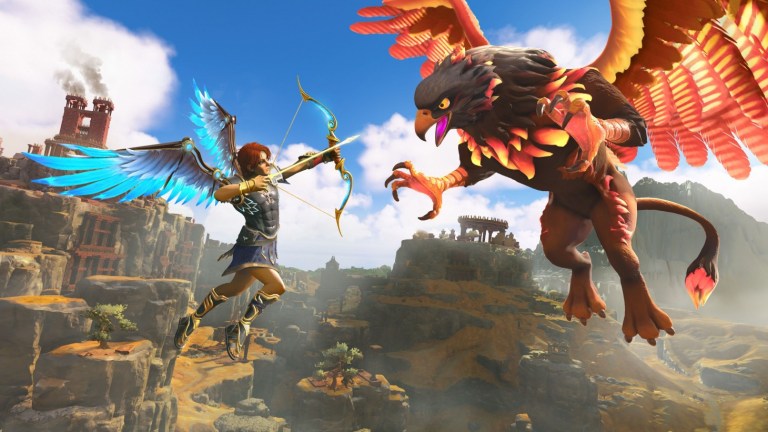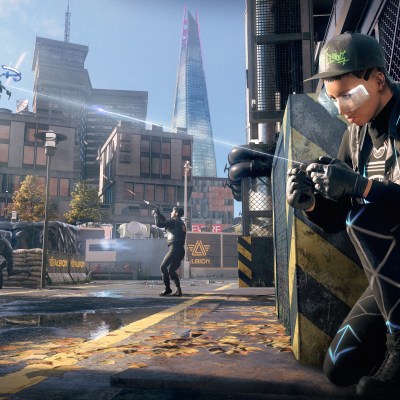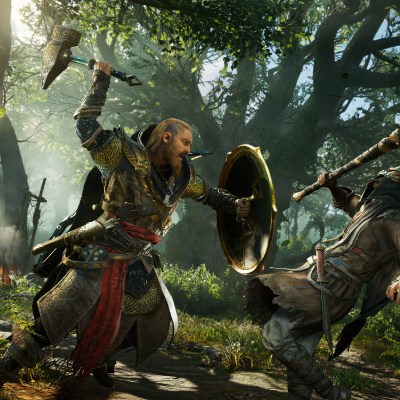Immortals: Fenyx Rising Review
Immortals: Fenyx Rising, a game many compared to The Legend of Zelda: Breath of the Wild before release, has turned out to be a big of a disappoinment.

A few weeks ago, I demoed Immortals: Fenyx Rising and liked what I saw: a new IP from Ubisoft with colorful visuals, an expansive open world steeped in Greek mythology, and a comedic story that presents the Olympian gods in a new way. Sadly, the game’s strengths quickly waned, and its plethora of weaknesses began to wear on me over the 25 hours I played Immortals for this review. While I have no intention of picking up this game again, that’s not to say I didn’t have fun with it at times.
The adventure is set in the Golden Isle, where Fenyx, a shipwrecked warrior (male or female), discovers that every mortal but them has been turned to stone by a monstrosity named Typhon, who was once banished by the gods but has returned for revenge and seemingly wiped them from existence. Only Zeus and his disgraced cousin Prometheus remain, and to his dismay, Zeus must listen to Prometheus as he narrates Fenyx’s journey to restore the gods’ power.
The game’s story and dialogue are amusing at first. The banter between Zeus and Prometheus is fun, and Fenyx’s interactions with the handful of characters she encounters are written well enough. But there’s an underlying issue with the material that becomes increasingly evident as the story unfolds. While the writing can be funny, the story aims for comedy way too often, which is to say none of the story beats feel sincere because the humor is so incessant. And because the humor is so incessant, the dialogue stops being funny rather quickly. Every character is made to look like an idiot in one way or another, which undermines any drama or stakes the story tries to introduce. I appreciate the Saturday morning cartoon vibe, but I would have liked to see a little more depth.
Another issue with the storytelling is the fact that there are, as previously mentioned, only a handful of NPCs to talk to. This makes the game world feel empty, lifeless, and lonesome, despite its beauty. All of the island’s denizens have been turned to stone, of course, but I would have still have preferred for the game world to be populated with more characters to talk to, especially since the game is so dialogue-driven. In open worlds I love, I find myself exploring just to explore because I simply enjoy being there. But in Immortals, I never took the long way to objectives—I fast-traveled like crazy because after the island’s beauty faded there wasn’t much left to draw me into the world.
The lack of NPCs is a shame because the island is so spacious and scenic. As you explore its six zones (each dedicated to one of the Olympian gods), its vastness is immediately striking, largely due to the near-limitless draw distance. You can see for miles and miles around when you climb one of the gigantic statues of the gods, and the game’s visuals pop with color. At times, the environments can lack a little visual depth due to the passable lighting system and the cartoony aesthetic, but overall I found the environmental design to be appealing.
As with every other aspect of this game, the more time you spend with the visuals, the more blemishes become apparent. The character models look okay at a glance, but the facial animations are woefully wooden and inexpressive to the point where they undermine the dialogue and look borderline silly. This comes as a surprise since artists typically choose a cartoon-like aesthetic to allow their characters to be MORE expressive. Sadly, Immortals’s characters look like they’re two console generations old.
Release Date: Dec. 3, 2020
Platforms: PC (reviewed), PS5, XSX/S, PS4, XBO, Switch, Stadia, Luna
Developer: Ubisoft
Publisher: Ubisoft
Genre: Action-adventure
Immortals’s gameplay is—surprise—a mixed bag. There are several ways to traverse the island. You can climb almost any surface (limited by a stamina bar), tame a mount, or glide around with Daedalus’s wings, which you acquire early on. These all work well enough, though the gliding mechanic can be finicky. There’s no way to move backwards, which can become incredibly frustrating during the game’s many air navigation puzzles.
Speaking of puzzles, let’s talk about the Vaults of Tartaros, which are scattered across the game world in great number. These challenge areas can be combat-based, navigation-based, or puzzle-based, and the latter two are just awful to play. I can’t tell you how much I loathed spending time in these vaults, and there are so many reasons why that I don’t care to list them all for fear of popping a vein in my forehead.
But here are a few. Worst of all is the look of the vaults. They all look the same: stone structures suspended in a generic-looking cosmic backdrop. Everything is blueish or purplish, which makes clues almost impossible to see at times due to the lack of visual contrast. And everything is square—virtually every component of the structures in Tartarus is a cube or a square, which becomes mind-numbing and frankly infuriating.
And then there are the puzzles themselves, which are inelegant and uninspired. You’re pushing blocks, pulling blocks, breaking blocks, shooting targets, rolling spheres. The puzzles are mostly physics-based, and they almost always feel janky in some way. Without going into detail, I’ll just say that 90% of the time, when I solved a puzzle, I was unsure whether the solution I arrived at was the intended result or if I’d randomly stumbled upon a wonky way to cheat my way through. And on too many occasions I had no clue where I was supposed to go next during a puzzle. I’d hit a switch and I’d hear a sound, but the camera never moves to show you what the switch actually activated.
In games with good puzzles, you’re stumped for awhile but you’re compelled to solve them because they’re visually attractive, or the puzzle is designed in a way that captures your imagination and pulls you through to the end. Immortals’s puzzles feel like putting together a jigsaw whose pieces don’t quite fit flush, or a jigsaw that comes with extra pieces just to troll you. Really messy stuff.
Thankfully, the most prominently featured aspect of gameplay is pretty great. The game’s combat reminds me of Darksiders, which I consider a huge compliment. You use quick sword attacks to chip away at enemies’ health, sweeping axe attacks to rack up stagger points, and bow attacks for ranged damage. The action feels quick, responsive, and dynamic most of the time.
There are mythical boss fights to be found all over the island as well, and these legendary encounters were enjoyable not just to play but to find. I loved spotting a hulking cyclops in the distance and making my way over to them, readying my inventory for the epic battle at hand. The combat is a huge plus for a game that suffers in most other areas.
You have myriad god abilities at your disposal to help you in battle, like a massive hammer swing that breaks through shields; Apollo’s arrows, whose trajectory you can guide manually; and Phosphor, a bird ally who can attack baddies alongside you. Potions play a major role as well: You’ve got health and stamina potions, and attack and defense potions that increase your stats. All of these tools and skills can be upgraded via the game’s central hub, the Hall of the Gods, where you can spend various currencies and improve your Fenyx as well as complete rotating tasks for Hermes (essentially the same as the Vault challenges).
Unfortunately, for every one thing Immortals does right, it does five things wrong. The various armors that you collect are all pretty cool looking and come with unique stat buffs, but unlocking them often requires you to solve tedious puzzles, which again, are no fun for a litany of reasons. I really wanted to like this game—it reminded me of ’90s games like ActRaiser with its art style and arcade-y action. But over time I was bludgeoned by the game’s shortcomings and came away seriously disappointed.


